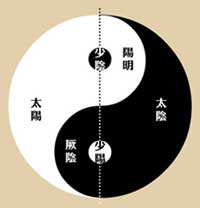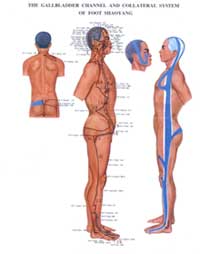Traditional Chinese medicine has a history of more than 3,000 years. According to archaeological research, writings on medicine first appeared in the period from the 11th to the 3rd century BC. Some Chinese medical books have had a far-reaching influence on the science of medicine. The Canon of Internal Medicine, written by unknown medical scholars during the Warring States Period (476--221 B.C.), is regarded as the first comprehensive medical text. This book gives detailed descriptions of human anatomy, morbid anatomy, pathological physiology, diagnosis, treatment, and prevention of disease. It lays the theoretical foundation for traditional Chinese medical theory.
Another medical book, Shen Nong's Materia of Medica, written around the second century B.C., is the earliest extant classic on Chinese pharmacology. It is a summary of the use of medical substances. Three hundred sixty five kinds of herbs, as well as some pharmacological theories, are listed. The effectiveness of these specific medicines has been confirmed by modem pharmacologists.
During the period from the Eastern Han Dynasty (24--220) to the Western Jin Dynasty (265--317), many outstanding doctors appeared in China. Among them, Hua Tuo and Zhang Zhongjing were the most celebrated. Hua Tuo's invention and application of Ma Fei San, a kind of anesthetic, greatly advanced the development of surgical operations. Zhang Zhongjing, combined what he had learned from studying available medical classics and his own research in clinical practice in a book called Treatise on Febrile and Miscellaneous Diseases. The book established Chinese medicine's theoretical system, therapeutic principles, diagnosis and treatment based on an overall analysis of signs and symptoms.
In the Tang Dynasty (618--907), Sun Simiao, a famous physician, devoted his whole life to writing Prescriptions for Emergencies Worth a Thousand Gold. The book, for the first time in Chinese medical history, systematically dealt with acupuncture and moxibustion, diet therapy, and other important medical practices.
Traditional Chinese medicine witnessed rapid and wide spread development during the Song Dynasty (960--1279), when the Imperial Medical Bureau, the supreme institution for educating qualified doctors, was established by the government.
Li Shizhen was a great physician, naturalist and pharmacologist of the Ming Dynasty (1368--1644). He was very interested in the proper classification of the components of nature. His major contribution to medicine was a forty year analysis of the vast amount of available herbal lore and recording the information that he thought was reliable. He devoted 27 years to writing Bencao Gangmu, which was printed in 1596. This 52 volume medical encyclopedia contains descriptions of 1,892 medicines with illustrations and 11,000 prescriptions in 16 different categories. His work involves information from many fields--geology, botany, zoology, mineralogy and geography. It has been translated into more than 10 foreign languages. The English scientist Charles Darwin called it "the ancient Chinese encyclopedia." Five of the original editions still exist.
The Qing Dynasty (1644--1911) witnessed outbreaks of devastating infectious diseases. The school of epidemic febrile diseases was founded to study these diseases. According to this school, people, strong or weak, old or young, fell ill from the air they breathed. Previously it had been through that diseases entered the human body only through its surface.
Theoretical Basis of Traditional Chinese Medicine
Traditional Chinese medicine is mainly based on the following three theories:
 1. Yin and Yang
1. Yin and Yang
This theory holds that everything in the world consists of two basic forces, Yin and Yang. These two forces not only oppose but also complement each other. Yin and Yang exist inside and outside of every tissue and structure of the human body. When there is a balance between the two, there is no disease; if the balance is disturbed, illness is sure to follow.
2. Five elements
The material world is basically made up of five elements, metal, wood, water, fire, and earth. These five elements move and change constantly to promote and restrain each other. The human body is part of the physical world and the liver, heart, spleen, lungs and kidney correspond with the five elements in the universe. The liver, for example, is considered to have the quality of wood that can be easily lit up by fire. Thus, a man with a liver disorder becomes angry easily.
3. Jing and luo
 This theory holds that the internal organs are all linked by channels through which blood and 'qi' (vital energy) circulate. The main channels that run longitudinally are called 'jing' while the branches that run latitudinally are regarded as 'luo'. The blockage of blood and 'qi' in either 'jing' or 'luo' has serious effects on a person's health. The fundamental step in curing diseases is to clear the blockage to ensure the free flow of blood and 'qi'.
This theory holds that the internal organs are all linked by channels through which blood and 'qi' (vital energy) circulate. The main channels that run longitudinally are called 'jing' while the branches that run latitudinally are regarded as 'luo'. The blockage of blood and 'qi' in either 'jing' or 'luo' has serious effects on a person's health. The fundamental step in curing diseases is to clear the blockage to ensure the free flow of blood and 'qi'.
Guided by these three basic theories, doctors of traditional Chinese medicine emphasize treatment of the whole body, which is aimed at readjusting its balance.
Diagnosis in Traditional Chinese Medicine
A diagnosis is made by one or a combination of four basic methods: observing, auscultation, inquiring, and pulse palpating. Observing is to thoroughly inspect the patient's vitality, complexion, physical condition and behavior, secretion, appearance of tongue, etc. Auscultation is to judge pathological changes by listening to the patient's voice, moans, breathing and cough.
Pulse palpating, regarded as the most important of the four, is important for discovering the condition of the viscera, and the quality, power, and rhythm of the patient's pulse. A practitioner uses his hand to touch or press parts of the patient's body. An excellent doctor can distinguish more than 30 types of pulse and therefore diagnose disease. Knowledge of anatomy and physiology is indispensable in pulse palpating.
The first consideration in pulse palpating is the relationship between the heart, blood, and blood vessels. The pulse, according to The Yellow Emperor's Canon of Internal Medicine, mirrors the condition of the blood and the function of the heart. The pulse and heart are co-related. The pulse keeps pace with the heartbeat and stops when the heart dies.
The second consideration is the relationship between breathing rate and pulse rate. A passage in The Yellow Emperor's Canon of Internal Medicine states that two pulse beats are felt when one inhales and another two follow when one exhales--when 18 breaths are taken per minute, there are 72 pulsations.
Ancient Chinese medical practitioners were able by pulse palpating to tell whether a disease was ''cold'' or ''warm'' in nature and whether the patient's 'qi' was growing or declining.

